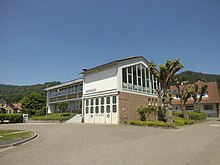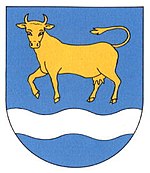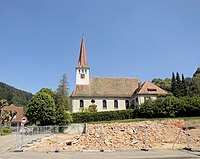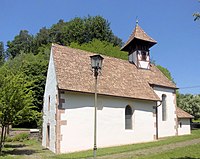Kuhbach (Lahr)
|
Kuhbach
City of Lahr / Black Forest
|
|
|---|---|
| Coordinates: 48 ° 20 ′ 19 ″ N , 7 ° 54 ′ 33 ″ E | |
| Height : | 187 m |
| Area : | 1.85 km² |
| Residents : | 1600 |
| Population density : | 865 inhabitants / km² |
| Incorporation : | January 1, 1972 |
|
Kuhbach near Lahr (spring 2010)
|
|
Kuhbach is a district of the city of Lahr / Black Forest .
The formerly independent municipality of Kuhbach is today the second smallest district of Lahr with around 185 hectares and 1,600 inhabitants. The village lies in the valley of the 55-kilometer-long Schutter and extends along the federal road 415 , bounded by the Black Forest foothills, the core town of Lahr and the neighboring district of Reichenbach .
geography
location
Kuhbach is located on the western edge of the Black Forest, on the eastern side of the Rhine plain at the foothills of the Schuttertal. The Schutter flows through the place, coming from the Black Forest. The community is nestled in a valley between Lahr and the front Black Forest. The expansion possibilities for Kuhbach are limited to the north and south by the Black Forest foothills, to the east by the Reichenbach district and to the west by the city center.
climate
Kuhbach lies in a zone with a warm and humid temperate climate, although there are major differences: on the plains it is warmer and drier, in the surrounding forests it is rather cool and fresh. Because of the mean average temperature of 10.8 ° C, the municipality is one of the warmest in Germany.
With an average of 1,700 hours of sunshine per year, Kuhbach also takes a leading position.
history
Rule of the Geroldsecker
Kuhbach, first mentioned in 1035 under the name "Cuobach", was the second smallest municipality in the old Lahr district with its 185 hectares. The small area was probably the reason that only a few families could make a living from agriculture in the previous century. Although the place is surrounded by forests both in the north and in the south, the community only had 11 hectares of forest. Kuhbach initially belonged to the Geroldseckern and came to Hohengeroldseck (Vogtei Seelbach) when it was divided in 1278. Ecclesiastically it belonged first to the Burgheimer church , then to the parish Lahr. After the Counter Reformation in Hohengeroldseck , the place became Catholic again. The old Gallus Church at the entrance to the Brudertal is a witness to the history of Kuhbach. Investigations during the renovation in 1974 revealed that the church was built between 1249 and 1253. This is also the time when Geroldseck Castle was built. Since the renovation, church services have been held regularly in the Gallus Church. The pilgrimage in the Brudertal was known far beyond the boundaries of the district for centuries. The “pilgrimage to the painful Mother of God” has seen many ups and downs in its almost thousand-year history. At the turn of the millennium, up to 5000 believers met on the traditional days of pilgrimage. Even today several parishes from the Ortenau celebrate their parish pilgrimage in the Brudertal.
Grand Duchy of Baden
When the rule of the Principality of Hohengeroldseck ended in 1819, Kuhbach came to the Grand Duchy of Baden.
19th and 20th centuries
For a long time, the Kuhbach citizens found work in the well-known quarries that supplied the widely coveted red sandstone until the 1950s. Today only a quarry on the boundary of Lahr bears witness to this quarrying tradition. After the Second World War, Kuhbach developed more and more into a pure residential community. The traditional operations such as the quarries, the pillar and cigar factories came to a standstill. Agriculture was almost only a sideline. Nevertheless, the local politicians tried to set up business in the 1950s, and they managed to set up an electronic company in Kuhbach. At times, up to 400 people found work in this company. With this hefty trade tax payer behind them, the community was able to venture into the construction of all public buildings. So until the incorporation, which came into effect on January 1, 1972, a new town hall with fire station , the school house and the festival hall were completed. The economic decline of this company at the beginning of the 1980s therefore hit the district particularly hard. Production was finally stopped in June 1991, and the company's buildings on the southern edge of Kuhbach were partly used as accommodation for asylum seekers and partly as storage facilities. At the beginning of 1996 this use also came to an end. No suitable use could be found for the factory buildings, which were erected with great expectations over 30 years ago.
21st century
Kuhbach has developed into a pure residential community, with a kindergarten and elementary school, with the necessary shops and facilities, church communities, organizations and associations. Special plus points of the place are the immediate proximity to the core city of Lahrs, also the proximity to nature, to the forest, which, however, is offset by a major minus point, the busy B415 federal road.
politics
Local constitution
The local constitution applies in Lahr . This means that there is a local administration and a local council with a local chief in all Lahr districts. The members of the local council are elected every five years by the citizens of the respective district. The local council advises the local administration. The municipal council must take into account the opinion of the representatives of the district council when making decisions on important local matters. The local council is supposed to advise the local administration and has the right to make proposals in all matters affecting the district. He is to be heard on important matters affecting the district before the decision is made by the responsible bodies. For areas of responsibility that have been assigned to the local council, it decides instead of the local council. In addition, the local councils can make suggestions to the local council for all matters in their district.
Local administration
The local administration employees are the first point of contact for citizens in numerous administrative matters. You get in this device z. B. Services in the population registration system, passport and ID card, funeral or driving license matters. The mayor and the local administrations prepare the meetings of the local councils and implement their resolutions.
Mayor
The mayor constantly represents the mayor and the councilors in the implementation of the resolutions of the local council and in the management of the local administration.
The mayor of the Kuhbach community is Norbert Bühler ( SPD ), his deputy is Stephan Müller ( CDU ).
coat of arms
In blue, over a lowered silver wave bar, a golden cow with a bent tail looking forward.
education
Kuhbach has a primary school with grades 1 to 4. 81 pupils, 35 of them girls and 46 boys, attended the school at the beginning of 2009 and were taught by five teachers. The school is located on the southern slope of the village in the immediate vicinity of the forest. The municipal kindergarten is located in the same building as is the sports and festival hall. Since the 2002/03 school year there has been the possibility of afternoon care by the AWO's socio-educational student aid (homework as well as leisure and creative areas). After completing elementary school, the students usually switch to the Seelbach Realschule, the Max Planck Gymnasium Lahr or the Clara Schumann Gymnasium Lahr .
Infrastructure
The busy B415 federal road runs through Kuhbach, on which a speed limit of 40 km / h has been in effect since May 16, 2008. Kuhbach benefits from its proximity to the core city of Lahr and its close proximity to nature and forest. Cycle paths lead to the center of Lahr.
Sports and leisure offers
The most important organizations and associations from Kuhbach include the DRK local group Kuhbach / Reichenbach, the volunteer fire brigade Lahr (Kuhbach department), the creative sports club, the Kuhbach music association, the fruit and horticultural association , the Lahr / Kuhbach wrestling association, the Kuhbach-Reichenbach Black Forest association , the sports club Kuhbach / Reichenbach, the singing group of the Catholic parish and the VdK local group Kuhbach. For a few years now, the bowling alley has been used as a meeting place for young people.
Church organizations
Parish of the Visitation of the Virgin Mary
The parish church of the Visitation of the Virgin Mary, built in 1908, is the still visible meeting place of around 1000 Catholics from the Kuhbach district. The parish church has been renovated in recent years with the great help of parishioners and is the stylish place for festive church services. In addition to the equipment, the historic Stieffel organ also makes a significant contribution . In addition to the parish church, the parish has a gem, the venerable Gallus Church, built in the years 1253–1259. The interior is decorated with frescoes from the 14th century and a Gothic pieta. This church is mainly used for services during the week and for Vespers on weekends. The parish hall in Hauptstrasse should be mentioned as the third place of assembly. The former kindergarten was rebuilt in-house and can be used as a meeting place after church services and for celebrations during the year. Both churches, as well as the parish hall, are also used by Protestant fellow Christians. Women and men are active as lecturers, communion helpers as well as cantors, singers and musicians in the singing group, active in shaping the life of the community, as are girls and boys in the acolyte group.
- Churches in Kuhbach
Personalities
Two professional footballers come from Kuhbach who made their first experiences with today's club SC Kuhbach-Reichenbach, Sascha Riether and Timo Reus .
Individual evidence
- ^ Federal Statistical Office (ed.): Historical municipality directory for the Federal Republic of Germany. Name, border and key number changes in municipalities, counties and administrative districts from May 27, 1970 to December 31, 1982 . W. Kohlhammer, Stuttgart / Mainz 1983, ISBN 3-17-003263-1 , p. 498 .
- ^ Heraldry of the World , accessed January 3, 2011





